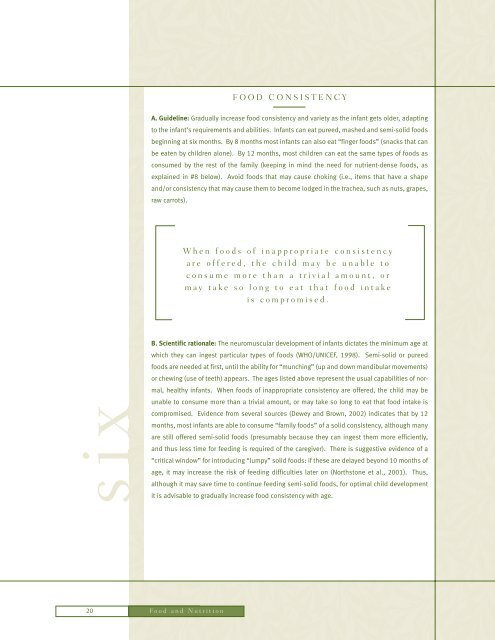Guiding Principles for Complementary Feeding of the Breastfed
Guiding Principles for Complementary Feeding of the Breastfed
Guiding Principles for Complementary Feeding of the Breastfed
Create successful ePaper yourself
Turn your PDF publications into a flip-book with our unique Google optimized e-Paper software.
six<br />
FOOD CONSISTENCY<br />
A. Guideline: Gradually increase food consistency and variety as <strong>the</strong> infant gets older, adapting<br />
to <strong>the</strong> infant’s requirements and abilities. Infants can eat pureed, mashed and semi-solid foods<br />
beginning at six months. By 8 months most infants can also eat “finger foods” (snacks that can<br />
be eaten by children alone). By 12 months, most children can eat <strong>the</strong> same types <strong>of</strong> foods as<br />
consumed by <strong>the</strong> rest <strong>of</strong> <strong>the</strong> family (keeping in mind <strong>the</strong> need <strong>for</strong> nutrient-dense foods, as<br />
explained in #8 below). Avoid foods that may cause choking (i.e., items that have a shape<br />
and/or consistency that may cause <strong>the</strong>m to become lodged in <strong>the</strong> trachea, such as nuts, grapes,<br />
raw carrots).<br />
B. Scientific rationale: The neuromuscular development <strong>of</strong> infants dictates <strong>the</strong> minimum age at<br />
which <strong>the</strong>y can ingest particular types <strong>of</strong> foods (WHO/UNICEF, 1998). Semi-solid or pureed<br />
foods are needed at first, until <strong>the</strong> ability <strong>for</strong> “munching” (up and down mandibular movements)<br />
or chewing (use <strong>of</strong> teeth) appears. The ages listed above represent <strong>the</strong> usual capabilities <strong>of</strong> normal,<br />
healthy infants. When foods <strong>of</strong> inappropriate consistency are <strong>of</strong>fered, <strong>the</strong> child may be<br />
unable to consume more than a trivial amount, or may take so long to eat that food intake is<br />
compromised. Evidence from several sources (Dewey and Brown, 2002) indicates that by 12<br />
months, most infants are able to consume “family foods” <strong>of</strong> a solid consistency, although many<br />
are still <strong>of</strong>fered semi-solid foods (presumably because <strong>the</strong>y can ingest <strong>the</strong>m more efficiently,<br />
and thus less time <strong>for</strong> feeding is required <strong>of</strong> <strong>the</strong> caregiver). There is suggestive evidence <strong>of</strong> a<br />
“critical window” <strong>for</strong> introducing “lumpy” solid foods: if <strong>the</strong>se are delayed beyond 10 months <strong>of</strong><br />
age, it may increase <strong>the</strong> risk <strong>of</strong> feeding difficulties later on (Northstone et al., 2001). Thus,<br />
although it may save time to continue feeding semi-solid foods, <strong>for</strong> optimal child development<br />
it is advisable to gradually increase food consistency with age.<br />
20 Food and Nutrition<br />
When foods <strong>of</strong> inappropriate consistency<br />
are <strong>of</strong>fered, <strong>the</strong> child may be unable to<br />
consume more than a trivial amount, or<br />
may take so long to eat that food intake<br />
is compromised.

















